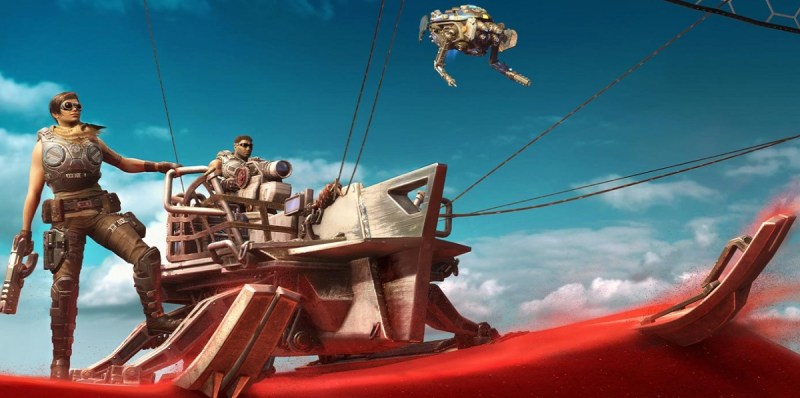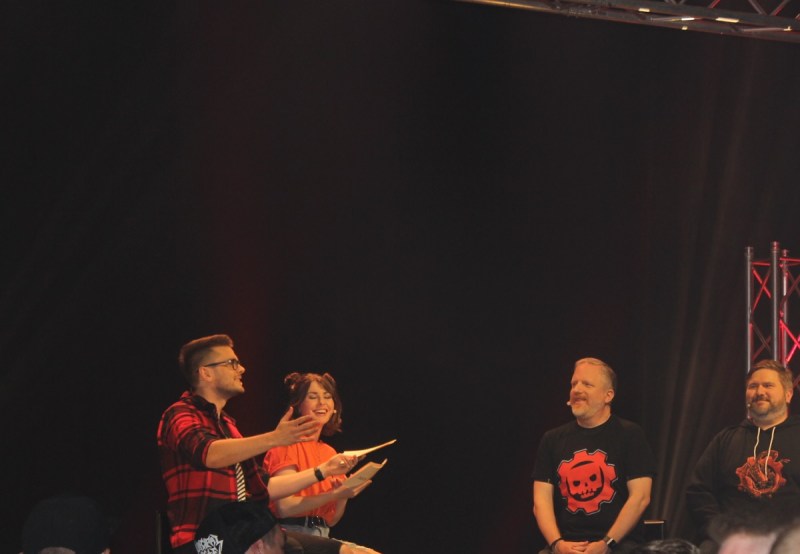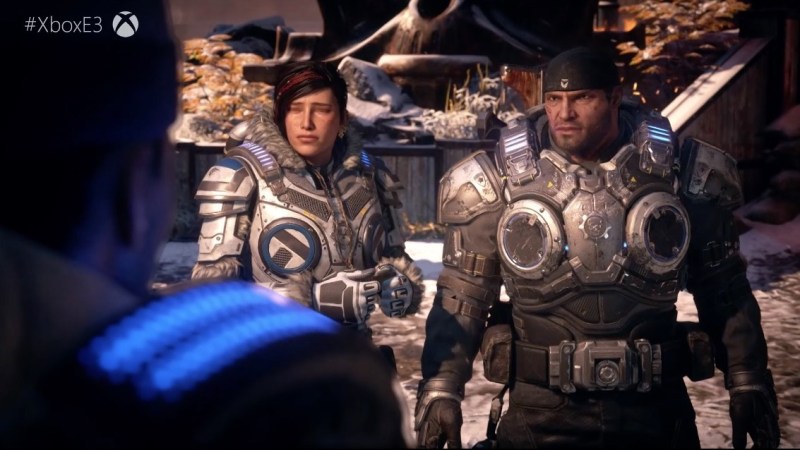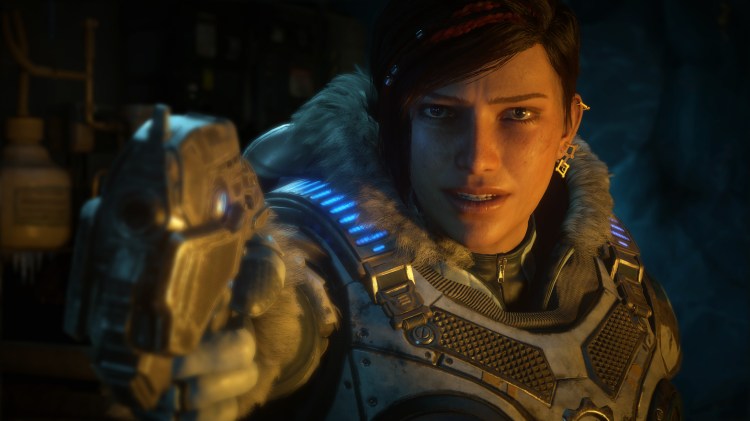
Above: Gears 5’s skiff gets you around the ice and sands.
GamesBeat: I did feel that it was a complete story, but there were probably two points where I felt like you held back. One was more obviously a conflict with her mother, the ultimate boss. It seems like that’s postponed for another day. And then the conflict with the COG as well, where Kait has this dual nature, and they’re not sure whether to trust her. It almost felt like they were on the verge of mistrusting her, but they never really got to that point. I don’t know if that’s something that’s held back in way.
Fergusson: Those are things that we wanted to — we like to create negative space, in the sense of places we can go and opportunities to explore. Part of what I like about Gears games — this is the first Gears we ever did with time elapsing. Normally a Gears game is about 24 or 36 hours. It’s almost real time. This time we have the four-month gap in act one and act two.
As you go from act three into act four, when Jinn is confronting her, you don’t really have time for that to resolve. They’re under threat. They’re fighting. Same with her mother coming back and becoming the queen. It’s this notion of, this is the beginning of something. We knew that the war had to have a purpose. It couldn’t just be an infestation. Somebody had to have goals and lead the army of the enemy. We needed to have a queen. But part of it was we wanted to keep that discovery along the way. Those are definitely things that set up possibilities to explore moving forward.
GamesBeat: What is the fondness you have for the kaiju-like things? The big giant beasts. You have the guy who appears once, and then reappears toward the end. It’s very different from fighting the individual characters in big battles, compared to the one giant thing.
June 5th: The AI Audit in NYC
Join us next week in NYC to engage with top executive leaders, delving into strategies for auditing AI models to ensure fairness, optimal performance, and ethical compliance across diverse organizations. Secure your attendance for this exclusive invite-only event.
Fergusson: It’s just the way that we — the mech, what we call the Megamech, the Megamechs were a thing we put in at the end of Gears 4. It was a way to help fight your way to find her mom, to use these Megamechs to get deep into the enemy territory. Having Cole in the Megamech was a wink back to Gears 4. We didn’t want them to be in one game and just vanish. If you had this weapon, why wouldn’t you use it?
Then the idea of the scale, the Kraken that you fight through Vasgar and then back in the city, that’s just — Gears is known for large set-piece bosses. We wanted to see how big we could take it and still make it feel like something you could take down. That’s just part of what it is to be Gears. We always try to do big bombastic things.

Above: Rod Fergusson, third from left, intervewed at Microsoft’s event at Gamescom in Germany.
GamesBeat: Was there a reason you didn’t want to use the Megamech again as a playable feature?
Fergusson: We’d done it in 4. It was just sort of — when we looked at where we were going to put our effort in, we wanted to create a new experience, rather than to re-create an experience you already had in 4. We decided to put more effort into the new thing. That’s not to say we won’t ever revisit it, because we know it’s a lot of fun. It’s just a bunch of work. When you have to change the scale of the world and create the ability to stomp through buildings and walk around in a city like King Kong, it’s a non-trivial amount of work. [laughs] We just have to look at where we use it. But I like having that in our world as something we can lean into.
GamesBeat: I actually had a harder time — I think I enjoyed the battle with the Matriarch more. You had to do more outwitting in that particular battle.
Fergusson: Yeah, having her running around with a lot more mobility is certainly a challenge. Being able to use the ice, freezing her, and working against her. Creating compelling large boss fights is always a challenge. It’s one of those things. We always have the notion of, what can we bring over to Horde? The Matriarch has to be a great boss fight in the campaign, but then also has to be a great boss fight in Horde. You have to develop it with both things in mind. Things like the Kraken can’t be that. You can’t do that in Horde. We can focus on where it’s going to be in the story.
GamesBeat: The Matriarch herself, what is her significance? I know that Kait said her headaches went away after the Matriarch was gone. I didn’t quite understand what role the Matriarch was playing there.
Fergusson: I’ll try to explain that. Basically, Myrrah’s connection to the Locust was done through this conduit — the Matriarch acted as an antenna for them. The way Niles was able to connect Myrrah to the Locust was through the Matriarch.
The hive mind is trying to take control of Kait and get her to come back. She’s the last living descendant of the queen’s line, so the hive mind is reaching out for her, and doing that is giving her these visions and nightmares. Niles tricks her into using the Matriarch as this antenna, to go into the hive mind and wake up her mom. Basically the Matriarch is a conduit to the hive mind for her. Once they kill the Matriarch, they turn off that antenna and sever her link to the hive mind.
GamesBeat: What are some of the different ways to level up Jack that you might choose, or that players might think as they’re building up their different capabilities in the game?
Fergusson: It comes down to play style. The big one is that every ability has four upgrades. Three of them can be unlocked through finding components throughout the world. What I like is we didn’t make it a tech tree. They weren’t dependent on each other. You can decide how you want to do it. Not everyone is going to look exactly the same. Plus you can respec. When you stack three and have a bunch more abilities, you can decide, “Oh, I don’t use this one anymore. I’ll clear out the points and apply it to the new thing I use a lot.”

Above: Gears of War 5.
The biggest change — each ability has an ultimate. The way you get to Jack’s ultimates is by completing side missions or side quests. Even without any components, if you’re not finding anything to upgrade using components, you can still unlock these ultimate abilities. For example, one of my favorites is flash freeze. You have the basic ability to flash enemies — it stuns them and makes them stand up so you can headshot them, disorients them, that kind of thing — but when you go down a quest line in the ice level in act two, you get a freeze ability that adds to that flash.
Every time you flash something, it not only blinds and stuns them, but it also freezes them in place. That’s really useful, even in things like fighting the Matriarch. It means you can slow her down. You’re freezing her in the process. Going through and exploring — it’s a way of rewarding exploration and going down these different paths, not just staying on the main line. If you do these side quests, you’ll get a much stronger Jack out of it.
GamesBeat: Kait brings the diversity of the cast front and center this time. How did you guys think about diversity within the cast of this game?
Fergusson: It’s something we’ve been thinking about from the very beginning. It just changes slightly. When we first worked on Gears one, our diversity was about ethnic diversity. You have Cole and Dom and Marcus. Then, as we progressed, around Gears 3 we were also focused more on gender diversity. We brought Anya and Sam in as playable characters as well. We just continue to think like that.
Diversity attracts diversity, but it’s not something that just happens. If you’re not thinking about it, you’re probably not going to do it. We had to make conscious effort. Fahz was a conscious effort. We wanted to have a south Asian character in the game. When we had an opportunity to create a new character, we decided that’s the ethnicity we wanted, to add more diversity to the cast. It’s a conscious effort for us, and we’ll keep trying to do more and more.
Gears isn’t completely Star Trek. It’s not a utopian world. But we try to make sure we have what we want to put forward. It’s important to have that. Having representation in the game is important. You can try to do something too much and not succeed, so everything we try to do in Gears is to feel authentic. We want to be authentically diverse. We try to do it incrementally in a way that feels like it’s part of our world.

